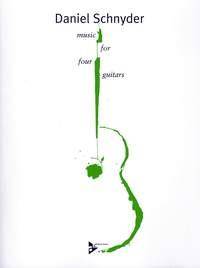- EAN13
- 9783892212645
- Éditeur
- ADVANCE
- Date de publication
- 1 janvier 2002
- Collection
- GUITARES
- Nombre de pages
- 72
- Dimensions
- 30,3 x 23,1 cm
- Poids
- 338 g
Music For Four Guitars, 4 Guitars. Partition Et Parties.
Daniel Schnyder
ADVANCE
Prix public : 45,64 €
Daniel Schnyder's 'Music for Four Guitars' reflects on various aspects of guitar music. The composition superimposes modern rhythms of South American provenience with European forms and compositional techniques. The fusion of these elements creates new music which at the same time sounds familiar. The combining of the two different worlds of music illuminates the diversity of today's music and it's beautiful possibilities on infinite new combinations. 'Unveiling of a Canon' is build on a canon, hidden behind rich ornamentations and melodic embellishments. The canon gradually unfolds as the piece develops. At the end of the movement the canon presents itself in its original form. The canon is the strictest musical form. The art of embellishments over a canon is rarely heard today. Jazz and jazz related music concentrate on improvising over chord structures - vertical structures - rather than improvsing over polyphonic patterns which by definition develop horizontally in a musical texture. Switching from the strict canon to embellishments creates tension between freedom and the strict hidden order. We know that very well from the music of J.S. Bach or Bela Bartok. 'Fairytale' is the pragmatic juxtaposition of a completely different way of musical thinking. The movement is based on harmonic and rhythmic fundamentals derived from Brazilian music. Basically the four guitars play on three different layers which rhythmically interact with each other: bass melody, rhythm with complimentary rhythm, and melody. For classically trained musicians the hidden African color of the music may be unusual, new and sophisticated. The accents are delayed to the off-beats. 'Fairytale' combines classical and non-European musical influences in a natural and sophisticated way. In spite of the unusual rhythmic approach, the audience will find this dance-like movement very accessible. 'Coding Against Memory' transforms the musical material from the canon, unweiled in the first movement, in a different way. Single elements of the canon have been isolated and consequently alongated, turned upside down, etc. These techniques are very fundamental and essential in the tradition of European art music but not really common in jazz and other non-written music. The third movement relates to movement one and reflects on the European roots and tradition. 'Dancing With My Lady' corresponds with the dance-like African quality of the second movement but with an emphasis on the inexaustible rhythmic vocabulary of South America, especially the energy-giving, high-spirited Samba. The whole piece therefore is written in a loose thematic ABAB form. This work was originally commissioned by the EOS Guitar Quartet and performed in numerous concerts. Instrumentation: 4 guitars


















